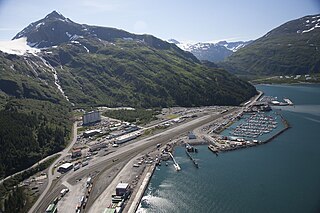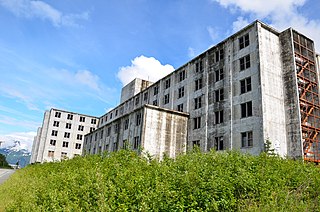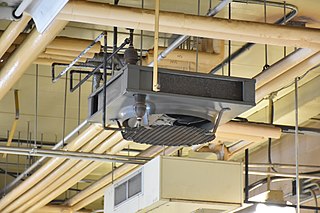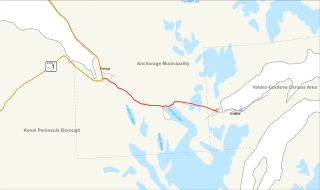
Arcology, a portmanteau of "architecture" and "ecology", is a field of creating architectural design principles for very densely populated and ecologically low-impact human habitats.

Whittier is a city at the head of the Passage Canal in the U.S. state of Alaska, about 58 miles (93 km) southeast of Anchorage. The city is within the Chugach Census Area, one of the two entities established in 2019 when the former Valdez–Cordova Census Area was dissolved. It is also a port for the Alaska Marine Highway. The population was 272 at the 2020 census, having increased from 220 in 2010.

Simon Bolivar Buckner Jr. was a lieutenant general in the United States Army during World War II who served in the Pacific Theater. As commanding general of Alaska Defense Command, Buckner commanded American-Canadian forces in the Aleutian Islands campaign, including the Battle of Attu and the Kiska Expedition. Following that assignment, he was promoted to command the Tenth Army, which conducted the amphibious invasion of the Japanese island of Okinawa in 1945. He was killed during the closing days of the Battle of Okinawa by enemy artillery fire, making him one of the highest-ranking United States military officers lost to enemy fire during World War II.

Nicholas Joseph Begich Sr. was an American politician who served as a member of the United States House of Representatives from Alaska. He is presumed to have died in the crash of a light aircraft in Alaska in 1972; his body was never found. He was a member of the Democratic Party.

A central heating system provides warmth to a number of spaces within a building from one main source of heat. It is a component of heating, ventilation, and air conditioning systems, which can both cool and warm interior spaces.

The Buckner Building is an abandoned former U.S. military building in Whittier, Alaska, on the Western edge of the Prince William Sound.

Mark Peter Begich is an American politician who served as a United States senator from Alaska from 2009 to 2015. A member of the Democratic Party, he served as mayor of Anchorage from 2003 to 2009.

Hydronics is the use of liquid water or gaseous water (steam) or a water solution as a heat-transfer medium in heating and cooling systems. The name differentiates such systems from oil and refrigerant systems.
The stack effect or chimney effect is the movement of air into and out of buildings through unsealed openings, chimneys, flue-gas stacks, or other containers, resulting from air buoyancy. Buoyancy occurs due to a difference in indoor-to-outdoor air density resulting from temperature and moisture differences. The result is either a positive or negative buoyancy force. The greater the thermal difference and the height of the structure, the greater the buoyancy force, and thus the stack effect. The stack effect helps drive natural ventilation, air infiltration, and fires.

Underfloor heating and cooling is a form of central heating and cooling that achieves indoor climate control for thermal comfort using hydronic or electrical heating elements embedded in a floor. Heating is achieved by conduction, radiation and convection. Use of underfloor heating dates back to the Neoglacial and Neolithic periods.

The 2008 United States Senate election in Alaska was held on November 4, 2008. Incumbent Republican U.S. Senator and former President pro tempore Ted Stevens ran for re-election for an eighth term in the United States Senate. It was one of the ten Senate races that U.S. Senator John Ensign of Nevada, the chairman of the National Republican Senatorial Committee, predicted as being most competitive. The primaries were held on August 26, 2008. Stevens was challenged by Democratic candidate Mark Begich, the mayor of Anchorage and son of former U.S. Representative Nick Begich.

A fan coil unit (FCU), also known as a Vertical Fan Coil-Unit (VFC), is a device consisting of a heat exchanger (coil) and a fan. FCUs are commonly used in HVAC systems of residential, commercial, and industrial buildings that use ducted split air conditioning or with central plant cooling. FCUs are typically connected to ductwork and a thermostat to regulate the temperature of one or more spaces and to assist the main air handling unit for each space if used with chillers. The thermostat controls the fan speed and/or the flow of water or refrigerant to the heat exchanger using a control valve.
Creative Energy is a private district heating company. The company was founded on November 1, 1968, by group of engineers with a desire to lower heating bills for buildings and reduce the amount of pollution being created to provide heat downtown. In 2014, Central Heat Distribution was rebranded as Creative Energy and began taking on additional district heating projects in Vancouver and Toronto.

A snowmelt system prevents the build-up of snow and ice on cycleways, walkways, patios and roadways, or more economically, only a portion of the area such as a pair of 2-foot (0.61 m)-wide tire tracks on a driveway or a 3-foot (0.91 m) center portion of a sidewalk, etc. It is also used to keep entire driveways and patios snow free in snow prone climates. The "snow melt" system is designed to function during a storm to improve safety and eliminate winter maintenance labor including shoveling, plowing snow and spreading de-icing salt or traction grit (sand). A snowmelt system may extend the life of the concrete, asphalt or under pavers by eliminating the use of salts or other de-icing chemicals, and physical damage from winter service vehicles. Many systems are fully automatic and require no human input to maintain a snow/ice-free horizontal surface.

Radiators and convectors are heat exchangers designed to transfer thermal energy from one medium to another for the purpose of space heating.

The Portage Glacier Highway, or Portage Glacier Road, is a highway located in the U.S. state of Alaska. The highway is made up of a series of roads, bridges, and tunnels that connect the Portage Glacier area of the Chugach National Forest and the city of Whittier to the Seward Highway. Most of the highway travels through mainly rural areas just north of the Kenai Peninsula, with the Anton Anderson Memorial Tunnel passing under Maynard Mountain, part of the Chugach Mountain Range. Parts of the route were first constructed in the early 1900s, and the entire highway was completed on June 7, 2000, as part of the Whittier Access Project. The main portion of the highway traveling from the western terminus to the Begich, Boggs Visitor Center at Portage Lake is designated as National Forest Highway 35 by the United States Forest Service (USFS).
Camp Sullivan was a United States Army camp located in Whittier, Alaska from 1943 to 1960. Constructed out of a need to supply the region with military support during World War II, the area became important again during the Cold War after the Army decided to build the 14-story Hodge Building completed in 1957 contained 150 two and three bedroom apartments plus bachelor efficiency units. Dependent families and Civil Service employees were moved into this efficient high rise. The new Whittier School was connected by a tunnel at the base of the west tower so students could go to school in short sleeves on the very worst weather days. The building, originally was named in honor of Colonel Walter William Hodge Civil. Engineer. the CO of 93rd Engineer Regiment on the Alcan Highway. The other structure, the Buckner Building, had been completed in 1953, and was called the "city under one roof". Both buildings were at one time the largest buildings in Alaska. The Begich Building is now a condominium. Together with the 2-story Whittier Manor, Begich Building houses nearly all of Whittier's residents. The port remained an active Army facility until 1960.

The 2018 Alaska gubernatorial election took place on November 6, 2018, to elect the governor and lieutenant governor of Alaska. In the primaries for recognized political parties, candidates for governor and lieutenant governor run separately. The winners of each respective primary for governor and lieutenant governor then become a joint ticket in the general election for their political party. Incumbent Independent governor Bill Walker was seeking re-election in what was originally a three-way race between Walker, Republican former Alaska state senator Mike Dunleavy, and Democratic former Alaska U.S. Senator Mark Begich. Despite Walker dropping out on October 19, 2018 and endorsing Begich, Dunleavy won in what was the only gubernatorial gain by a Republican candidate in 2018. As of 2024, this was the last time the Governor’s office in Alaska changed partisan control. Walker later unsuccessfully ran for Governor of Alaska in 2022.

The November 2022 United States House of Representatives election in Alaska was held on Tuesday, November 8, to elect a member of the United States House of Representatives to represent the state of Alaska. Democratic incumbent Mary Peltola won reelection to a full term in office, defeating Republicans Sarah Palin and Nick Begich III and Libertarian Chris Bye in the runoff count.


















